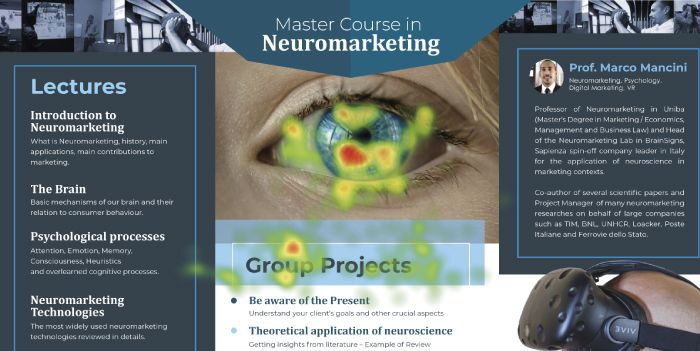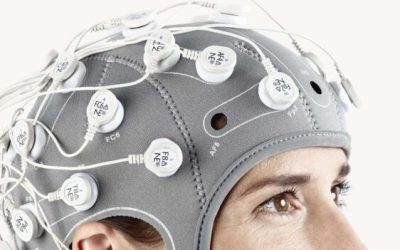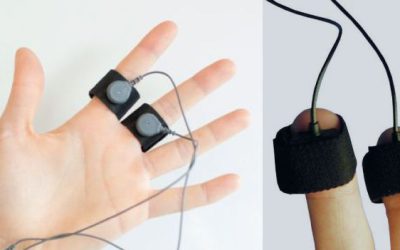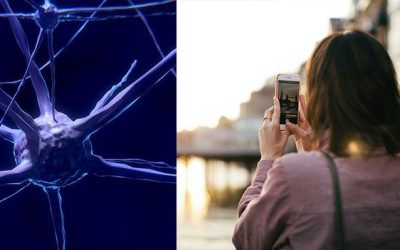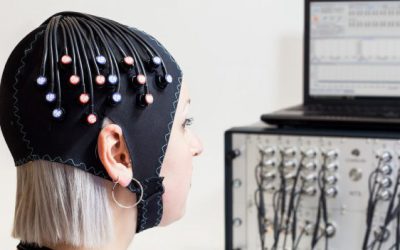The Neuromarketing course is a unique solution for students who decide to approach the world of neuroscience and its application to marketing.
The Neuromarketing course includes 50% lectures and 50% group projects, in order to make the course extremely practical and ensure the acquisition of crucial skills for the career of future marketing and communication experts or researchers.
Students are required to use their own laptop (in some cases made available by their university) and a good knowledge of Excel and PowerPoint.
The course ends with the written exam, which is based on the topics discussed during the lectures, and with the group presentation, based on practical exercises.
Neuromarketing Course Brochure
Frontal Lessons – Neuromarketing
During the lectures, students will take part in the following modules: Introduction to Neuromarketing, The Brain, Psychological Processes, Neuromarketing Technologies, NeuroTesting, Neuromarketing Case Studies.
Below you will find more specific details for each module.
1. Introduction to Neuromarketing
During the first module the goal is to answer a simple question: “What is Neuromarketing?”
In this phase of the course, the history of Neuromarketing will also be introduced, the main contributions that Neuroscience offer to Marketing experts and the aspects that differentiate this innovative approach from traditional marketing techniques.
2. The Brain
In the second module we will introduce the brain mechanisms that play a role of primary importance in forming the decision-making processes of consumers.
The association between our brain structures, brain functions and consumer behavior will represent the heart of this module.
3. Psychological Processes
During the third module the main psychological processes will be introduced and how Neuromarketing today plays a key role in the interpretation of these processes in marketing contexts.
The topics of greatest interest are those relating to emotional, attentional, memorization processes and cognitive shortcuts most used by consumers, known by the name of heuristics.
4. Neuromarketing technologies
The fourth module will describe in detail the main neuroscientific technologies and techniques that are widely applied today in marketing research contexts. The technologies and techniques that will be discussed are:
Functional Magnetic Resonance Imaging (FMRI), Electroencephalography (EEG), Sensors for the detection of the Galvanic Skin Response (GSR) [also known as Electrodermal Activity (EDA) or Skin Conductance (SC)], Electrocardiography (ECG), Photoplethysmography or Plethysmography (PPG), Eye tracker (ET), Positron Emission Tomography (PET), Magnetoencephalography (MEG), Transcranial Magnetic Stimulation (TMS), Facial Coding, Implicit Reaction Test (IRTs).
5. NeuroTesting
During the fifth module, all the phases necessary for the development of a Neuromarketing research will be described in detail, from the beginning to the end.
During this module, Prof. Marco Mancini will share with the students his work experience within a company that deals with Neuromarketing research and the main applications in advertising communication, digital and customer experience will be illustrated through numerous examples. of outputs aimed at increasing the understanding of the results of neuroscientific techniques.
6. Neuromarketing Case Studies
During the sixth module, the most interesting case studies in the Neuromarketing field will be described.
Each case will be dealt with starting from the client company brief, and then going into the development of the Neuromarketing research design, the description of the experimental sample and the Neuromarketing techniques used, up to the data analysis, the discussion of the results and the main managerial implications.
Group Projects – Neuromarketing
The class is divided into different work groups where each group will simulate being, for the duration of the course, a company of Neuromarketing experts that must solve the problem shared by the client company.
1. Review of the client company’s brief
In this phase, the students will review the brief received in detail and collect general information on the client company which will be important to share internally through a short presentation.
2. Theoretical Application of Neuroscience
It is not always necessary to develop a new Neuromarketing study in order to provide timely answers to the client company. It is possible that the answers that the company is looking for are already present in the scientific literature.
Through the theoretical approach of Neuroscience, students will identify which scientific contributions are most in line with the objectives of the client company and after the production of a report they will evaluate whether in the specific case it is really necessary to develop a new study or it is possible get clear answers directly from studying the literature.
3. Design and Research Proposal
The different groups in this phase will work on the production of a research proposal that meets the needs of the client company.
The proposal will include sections such as the presentation of the research team, the organization of the field, the Neuromarketing techniques that will be used, the main expected results, some examples of outputs, the final quotation.
4. Stimuli optimization
Before starting with the field search it is necessary to reproduce, recreate, modify the stimuli to be tested.
Depending on the type of brief received, the stimuli to be produced / modified in view of the test with the experimental subjects could be attributable to television advertisements, websites or applications.
In the case of websites and applications, students will be trained in the use of professional prototyping software that allow the creation of very high fidelity prototypes.
5. Analysis and interpretation of the results
Each group will receive neurophysiological data recorded with Neuromarketing techniques, relating to the interaction of the experimental subjects with the stimuli of interest.
The groups will explore the available data and conduct the analysis in order to identify the main research insights.
6. Report
In this phase, the goal of each group will be to produce a detailed report on the research carried out for the client company.
The section relating to the presentation of the main research results will play a crucial role and must be communicated to the client company with a simple, intuitive language that at the same time retains scientific rigor.
